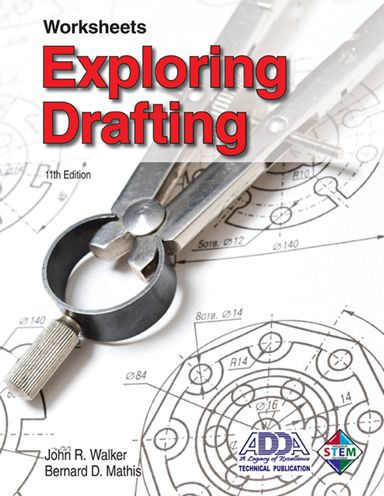Table of Contents
Chapter 1 Why Study Drafting? 2
Chapter 2 Careers in Drafting 10
Drafting Occupations 12
Industrial Designers 14
Tool Designers 14
Interior Designers 15
Teachers 16
Engineers 16
Architects 18
Model Makers 19
Technical Illustrators 19
Leadership in Drafting Technology 20
What to Expect When You Enter the World of Work 21
Where to Get Information about Careers in Drafting Technology 22
Time Management 22
Employer Expectations 22
Chapter 3 Sketching 26
Alphabet of Lines 29
Sketching Guidelines 34
Guidelines for Overlapping Lines 34
Sketching Geometric Shapes 34
Chapter 4 Drafting Equipment 54
Drawing Board 56
T-Square 56
Parallel Straightedge 57
Triangles 57
Drafting Machine 58
Compass 58
Dividers 59
Pencil Pointer 59
Erasers 60
Electric Erasers 60
Erasing Shield 62
Media Fasteners 62
Dusting Brush 63
Protractor 63
French Curves 63
Templates 63
Drafting Media 64
Pencils 67
Inking 68
Scales 68
Computer-Aided Drafting Equipment 70
Inspecting, Maintaining, and Servicing Drafting Tools 73
Working Safely 73
Chapter 5 Drafting Techniques 78
Line Conventions 80
Using a Scale 83
Drawing Lines with Instruments 87
Drawing a Line Perpendicular to a Given Line 90
Erasing Errors 91
Using a Compass 92
Darkening Lines 93
Attaching a Drawing Sheet to the Board 94
Drafting Sheet Formats 95
Chapter 6 Basic Geometric Construction 108
Solving Basic Geometric Problems 110
Chapter 7 Computer-Aided Drafting and Design 134
Overview of Computer Graphics and CAD 136
How CAD Works 137
File Management Functions 139
Basic CAD System Functions 139
Drawing Setup Functions 146
Creating Objects 146
Editing and Modifying Objects 148
Using Display Commands 151
Using Measurement, Object Property, and Drawing Status Commands 152
Using Help System Functions 153
CAD File Management and Storage Practices 155
Overview of CAD Systems and Software 156
Parametric Modeling 157
Assembly Modeling 163
Drawing Documentation 164
Advanced CAD Systems 166
Chapter 8 Lettering 186
Single-Stroke Gothic Lettering 188
Lettering with a Pencil 189
Guidelines 189
Spacing 190
Letter Height 191
Lettering Aids and Devices 191
Chapter 9 Multiview Drawings 204
Visualizing the Object and Projecting Views 206
Identifying Object Features 210
Primary and Secondary Views 213
True Faces and Foreshortening 214
Edges, Intersections, and Limiting Edges 217
Selecting Views to Be Drawn 217
Projecting Points and Edges 219
Centering a Multiview Drawing 221
Chapter 10 Dimensioning 238
Systems of Measurement Used in Dimensioning 240
Unidirectional and Aligned Dimensioning 241
Dimensioning a Drawing 241
Types of Dimensions 242
Fundamental Rules for Dimensioning 244
General Rules for Inch Dimensioning 248
Dimensioning Circles, Holes, and Arcs 248
Dimensioning Angles 254
Dimensioning Small Portions of an Object 256
Adapting US Customary Conventions to Metric Dimensioning 256
Tolerancing 261
Geometric Dimensioning and Tolerancing (GD&T) 262
Chapter 11 Sectional Views 278
Cutting-Plane Lines 281
Section Lines 282
Types of Sections 284
Chapter 12 Auxiliary Views 304
Projecting Inclined Surfaces and Drawing Auxiliary Views 306
Drawing Circular Features in Auxiliary Views 309
Revolutions 311
Chapter 13 Pictorials 322
Types of Projection 324
Overview of Pictorial Drawings 327
Principles of Axonometric Projection 329
Isometric Drawings 330
Oblique Drawings 334
Dimensioning Pictorial Drawings 335
Perspective Drawings 340
Exploded Assembly Drawings 344
Cutaway Pictorial Drawings 345
Centering Pictorial Drawings 346
Chapter 14 Pattern Development 362
Pattern Development and Manufacturing 365
Drawing Patterns 367
Pattern Development of a Rectangular Prism 371
Pattern Development of a Cylinder 372
Pattern Development of a Truncated Prism 373
Pattern Development of a Truncated Cylinder 374
Pattern Development of a Pyramid 375
Pattern Development of a Cone 376
Pattern Development of a Right Rectangular Pyramid 377
Chapter 15 Working Drawings 386
Detail Drawings 388
Assembly Drawings 390
Using Information on Working Drawings 393
Developing Working Drawings 395
Chapter 16 Making Prints 406
Making Original Drawings 408
Printing and Distributing CAD Drawings 408
Reproducing Drawings 410
Material Safety 413
Chapter 17 Design 416
Design Guidelines 419
Engineering Design Process 421
Chapter 18 Models, Mockups, and Prototypes 428
Models 430
Mockups 431
Prototypes 431
How Models, Mockups, and Prototypes Are Used 433
Constructing Models 436
Chapter 19 Maps 440
Preparing Maps 443
Maps Drawn by Drafters 443
Map Symbols 449
Chapter 20 Graphs and Charts 456
Graphs 458
Charts 463
Preparing Graphs and Charts 463
Computer-Generated Graphs and Charts 466
Chapter 21 Welding Drafting 470
Using Welding Symbols 474
Planning Welding Drawings for Assemblies 476
Chapter 22 Fasteners 484
Threaded Fasteners 486
Non-Threaded Fasteners 493
Fasteners for Wood 494
How to Draw Bolts and Nuts 494
Chapter 23 Electrical and Electronics Drafting 500
Overview of Electrical and Electronics Drafting 502
Types of Diagrams Used in Drafting 504
Drawing Electrical and Electronic Symbols 508
Chapter 24 Architectural Drafting 512
Building a Home 514
Types of Framing and Construction 515
Types of Plans 520
Drawing Architectural Plans 529
Dimensioning Architectural Drawings 533
Planning a Home 534
US Customary and Metric Measurement in Architecture 537
Chapter 25 Manufacturing Processes 546
Conventional Machine Tools 548
Modern Machine Tools 552
Metal Cutting and Forming Operations 556
Metal Casting Processes 557
Plastic Molding Processes 559
Additive Manufacturing 562
Reference Section 568
Glossary 604
Index 624






